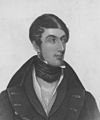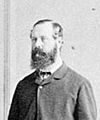
The Province of Canada was a British colony in British North America from 1841 to 1867. Its formation reflected recommendations made by John Lambton, 1st Earl of Durham, in the Report on the Affairs of British North America following the Rebellions of 1837–1838.

Canadian Confederation was the process by which three British North American provinces—the Province of Canada, Nova Scotia, and New Brunswick—were united into one federation, called the Dominion of Canada, on July 1, 1867. This process occurred in accordance with the rising tide of Canadian nationalism that was then beginning to swell within these provinces and others. Upon Confederation, Canada consisted of four provinces: Ontario and Quebec, which had been split out from the Province of Canada, and the provinces of Nova Scotia and New Brunswick. The province of Prince Edward Island, which had hosted the first meeting to consider Confederation, the Charlottetown Conference, did not join Confederation until 1873. Over the years since Confederation, Canada has seen numerous territorial changes and expansions, resulting in the current number of ten provinces and three territories.

Charles Stanley Monck, 4th Viscount Monck was a British politician who served as the last governor-general of the Province of Canada and the first Governor General of Canada after Canadian Confederation.

John Sandfield Macdonald, was the joint premier of the Province of Canada from 1862 to 1864. He was also the first premier of Ontario from 1867 to 1871, one of the four founding provinces created at Confederation in 1867. He served as both premier and attorney general of Ontario from July 16, 1867, to December 20, 1871.
The Farmer's Joint Stock Bank was a bank that operated in Upper Canada, and later in the Province of Canada, from 1834 to 1854.

Sir Dominick Daly was a British colonial public servant and administrator during the 19th century, who held positions in British North America, Tobago and South Australia.

Government House was the official residence of the lieutenant governor of Upper Canada and Ontario, Canada. Four buildings were used for this purpose, none of which exist today, making Ontario one of four provinces not to have an official vice-regal residence.

The Legislative Council of Upper Canada was the upper house governing the province of Upper Canada. Modelled after the British House of Lords, it was created by the Constitutional Act of 1791. It was specified that the council should consist of at least seven members. Members were appointed for life but could be dropped for non-attendance. The first nine members of the council were appointed on 12 July 1792. The speaker was usually the Chief Justice of the Court of King's Bench. The Legislative Council was dissolved on 10 February 1841 when Upper and Lower Canada were united into the Province of Canada. Some members were reappointed to the Legislative Council of the united Province.
The Legislative Assembly of the Province of Canada was the lower house of the Parliament of the Province of Canada. The Province of Canada consisted of the former province of Lower Canada, then known as Canada East, and Upper Canada, then known as Canada West. It was created by The Union Act, 1840.
The Legislative Council of the Province of Canada was the upper house for the Province of Canada, which consisted of the former provinces of Lower Canada, then known as Canada East and later the province of Quebec, and Upper Canada, then known as Canada West and later the province of Ontario. It was created by The Union Act of 1840. With the lower house, the Legislative Assembly of the Province of Canada, the two houses constituted the Parliament of the Province of Canada.
Hamilton Hartley Killaly was a civil engineer and political figure in Canada West.

James Leslie was a Canadian businessman and political figure. An immigrant from Scotland in 1804, he became a successful Montreal businessman and was one of the founders of the Bank of Montreal.
Louis Lacoste was a notary and political figure in Lower Canada and then Canada East, Province of Canada. He was a member of the Legislative Assembly of Lower Canada, supporting Louis-Joseph Papineau and the Parti patriote. During the Lower Canada Rebellion he was imprisoned without trial, for his activities in the lead-up to the Rebellion. Following the creation of the Province of Canada, he was a member of the new Legislative Assembly for several years, and then a member of the Legislative Council. He was one of the original members of the Senate of Canada from 1867 to 1878.
The Executive Council of the Province of Canada had a similar function to the Cabinet in England but was not responsible to the Legislative Assembly of the Province of Canada from its inception in 1841 to 1848.
David Morrison Armstrong was a merchant, insurance agent and political figure in Canada East in the Province of Canada. He represented the electoral district of Berthier in the Legislative Assembly of the Province of Canada from 1841 to 1851. From 1855 to 1867 he sat in the Legislative Council of the Province of Canada, and in the Legislative Council of Quebec from 1867 until his death. He initially opposed the union of the Lower Canada and Upper Canada into the Province of Canada, and supported the reform movement for responsible government. After responsible government was achieved, he gradually became a Conservative.

John Elmsley was Chief Justice of Upper Canada and afterwards of Lower Canada. In both of the Canadas he served as President of the Executive Council and Speaker of the Legislative Council. During the Hunter administration, he was the most powerful man in Upper Canada. In Lower Canada, from 1802 until his death he was second only in rank to the Lieutenant Governor.

The Parliament of the Province of Canada was the legislature for the Province of Canada, made up of the two regions of Canada West and Canada East.
Leeds was an electoral district of the Legislative Assembly of the Parliament of the Province of Canada, in the eastern area of Canada West. Leeds was created in 1841, upon the establishment of the Province of Canada by the union of Upper Canada and Lower Canada. It was based on Leeds County, located on the north shore of the Saint Lawrence River.

Section 69 of the Constitution Act, 1867 is a provision of the Constitution of Canada creating the Legislature of the province of Ontario, which did not exist prior to 1867. The Constitution Act, 1867 created Ontario, including the institutions of the new provincial government, such as the Legislature.

Section 68 of the Constitution Act, 1867 is a provision of the Constitution of Canada relating to the seats of government of the four original provinces, New Brunswick, Nova Scotia, Ontario and Quebec.

















